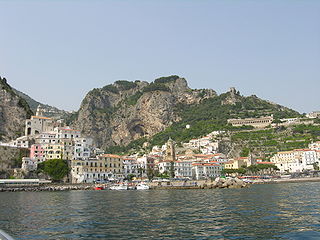
Amalfi is a town and comune in the province of Salerno, in the region of Campania, Italy, on the Gulf of Salerno. It lies at the mouth of a deep ravine, at the foot of Monte Cerreto, surrounded by dramatic cliffs and coastal scenery. The town of Amalfi was the capital of the maritime republic known as the Duchy of Amalfi, an important trading power in the Mediterranean between 839 and around 1200.

Positano is a village and comune on the Amalfi Coast, in Campania, Italy, mainly in an enclave in the hills leading down to the coast.
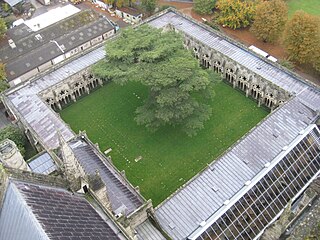
A cloister is a covered walk, open gallery, or open arcade running along the walls of buildings and forming a quadrangle or garth. The attachment of a cloister to a cathedral or church, commonly against a warm southern flank, usually indicates that it is part of a monastic foundation, "forming a continuous and solid architectural barrier... that effectively separates the world of the monks from that of the serfs and workmen, whose lives and works went forward outside and around the cloister."

The Amalfi Coast is a stretch of coastline in southern Italy overlooking the Tyrrhenian Sea and the Gulf of Salerno. It is located south of the Sorrentine Peninsula and north of the Cilentan Coast.

Ravello is a town and comune situated above the Amalfi Coast in the province of Salerno, Campania, Southern Italy, with approximately 2,500 inhabitants. Its scenic location makes it a popular tourist destination, and earned it a listing as a UNESCO World Heritage Site in 1997.

Maiori is a town and comune on the Amalfi coast in the province of Salerno. It has been a popular tourist resort since Roman times, with the longest unbroken stretch of beach on the Amalfi coastline.

Amalfi is town and municipality of the Colombian Andes, northern part of the Central Mountain Range in the Antioquia Department and part of the subregion of Northeastern Antioquia. The territory of Amalfi is bordered by the municipalities of Anorí and Segovia at its north; Segovia, Remedios and Vegachí at the east; Vegachí, Yalí, Yolombó and Gómez Plata at the south and Anorí and Guadalupe at the west. The town is served by Amalfi Airport.

The Duchy of Amalfi or the Republic of Amalfi was a de facto independent state centered on the Southern Italian city of Amalfi during the 10th and 11th centuries. The city and its territory were originally part of the larger ducatus Neapolitanus, governed by a patrician, but it extracted itself from Byzantine vassalage and first elected a duke in 958.

The Duchy of Naples began as a Byzantine province that was constituted in the seventh century, in the reduced coastal lands that the Lombards had not conquered during their invasion of Italy in the sixth century. It was governed by a military commander (dux), and rapidly became a de facto independent state, lasting more than five centuries during the Early and High Middle Ages. Naples remains a significant metropolitan city in present-day Italy.

Atrani is a city and comune on the Amalfi Coast in the province of Salerno in the Campania region of south-western Italy. It is located to the east of Amalfi, several minutes drive down the coast.
Cetara is a town and comune in the province of Salerno in the Campania region of south-western Italy. It is located in the territory of the Amalfi Coast.
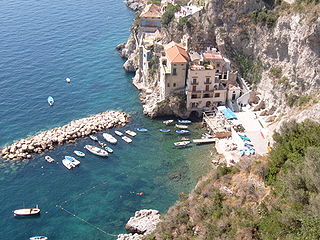
Conca dei Marini is a town and comune in the province of Salerno in the Campania region of south-western Italy. It is situated on a hill close to the coast and between Amalfi and Furore.
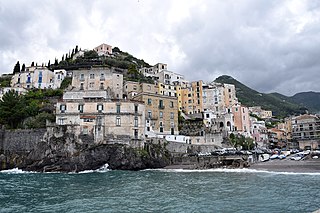
Minori is a comune in the province of Salerno, in the Campania region of south-western Italy. As a part of the Amalfi Coast, it was declared a UNESCO World Heritage Site in 1997.

Praiano is a town and comune of the province of Salerno in the Campania region of southwest Italy. It is situated on the Amalfi Coast, a prime tourist location for the region and Italy alike, between the towns of Amalfi and Positano.
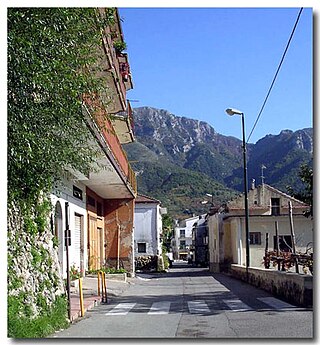
Tramonti is a town and comune in the province of Salerno in the Campania region of south-western Italy. It is located in the territory of the Amalfi Coast.

Scala is a town and comune in the province of Salerno in the Campania region of south-western Italy. It is located on a rocky hill c. 400 m above sea-level and is part of the Amalfi Coast.

The Archdiocese of Amalfi-Cava de' Tirreni is an archdiocese of the Latin Church of the Catholic Church, with its episcopal see at Amalfi, not far from Naples. It was named Archdiocese of Amalfi until parts of the Diocese of Cava e Sarno were merged with it on September 30, 1986.

The maritime republics, also called merchant republics, were Italian thalassocratic port cities which, starting from the Middle Ages, enjoyed political autonomy and economic prosperity brought about by their maritime activities. The term, coined during the 19th century, generally refers to four Italian cities, whose coats of arms have been shown since 1947 on the flags of the Italian Navy and the Italian Merchant Navy: Amalfi, Genoa, Pisa, and Venice. In addition to the four best known cities, Ancona, Gaeta, Noli, and, in Dalmatia, Ragusa, are also considered maritime republics; in certain historical periods, they had no secondary importance compared to some of the better known cities.

Amalfi Cathedral is a medieval Roman Catholic cathedral in the Piazza del Duomo, Amalfi, Italy. It is dedicated to the Apostle Saint Andrew whose relics are kept here. Formerly the archiepiscopal seat of the Diocese of Amalfi, it has been since 1986 that of the Diocese of Amalfi-Cava de' Tirreni.

Amalfi's Italian Restaurant, also known as Amalfi's Restaurant and Mercato, is an Italian restaurant in Portland, Oregon.

















